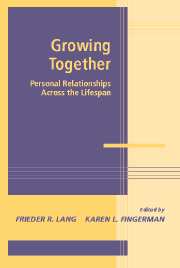Book contents
- Frontmatter
- Contents
- Contributors
- Acknowledgments
- 1 Coming Together: A Perspective on Relationships across the Life Span
- 2 Relationships as Outcomes and Contexts
- 3 Child-Parent Relationships
- 4 A Dynamic Ecological Systems Perspective on Emotion Regulation Development within the Sibling Relationship Context
- 5 Romantic and Marital Relationships
- 6 Close Relationships across the Life Span: Toward a Theory of Relationship Types
- 7 Friendship across the Life Span: Reciprocity in Individual and Relationship Development
- 8 The Consequential Stranger: Peripheral Relationships across the Life Span
- 9 Stress in Social Relationships: Coping and Adaptation across the Life Span
- 10 Social Support and Physical Health across the Life Span: Socioemotional Influences
- 11 Social Cognition and Social Relationships
- 12 Dyadic Fits and Transactions in Personality and Relationships
- 13 Relational Competence across the Life Span
- 14 Social Motivation across the Life Span
- 15 A Lifetime of Relationships Mediated by Technology
- Subject Index
- Author Index
- References
4 - A Dynamic Ecological Systems Perspective on Emotion Regulation Development within the Sibling Relationship Context
Published online by Cambridge University Press: 02 September 2009
- Frontmatter
- Contents
- Contributors
- Acknowledgments
- 1 Coming Together: A Perspective on Relationships across the Life Span
- 2 Relationships as Outcomes and Contexts
- 3 Child-Parent Relationships
- 4 A Dynamic Ecological Systems Perspective on Emotion Regulation Development within the Sibling Relationship Context
- 5 Romantic and Marital Relationships
- 6 Close Relationships across the Life Span: Toward a Theory of Relationship Types
- 7 Friendship across the Life Span: Reciprocity in Individual and Relationship Development
- 8 The Consequential Stranger: Peripheral Relationships across the Life Span
- 9 Stress in Social Relationships: Coping and Adaptation across the Life Span
- 10 Social Support and Physical Health across the Life Span: Socioemotional Influences
- 11 Social Cognition and Social Relationships
- 12 Dyadic Fits and Transactions in Personality and Relationships
- 13 Relational Competence across the Life Span
- 14 Social Motivation across the Life Span
- 15 A Lifetime of Relationships Mediated by Technology
- Subject Index
- Author Index
- References
Summary
This chapter presents a dynamic ecological systems model of emotion regulation. We focus on the course of the sibling relationship across the life span, making note of the connections between individuals' developing capacity to regulate their own emotions and the interpersonal nature of the sibling relationship. We introduce the concept of emotion other-regulation and note how siblings attempt to regulate their own emotions through attempts to influence others. We lay out a developmental timeline showing how parents regulate the relationship between their children during early childhood and how this parental control is slowly relinquished over time such that older children, adolescents, and adults become more responsible for the interpersonal regulation in their sibling relationship and, in turn, their own emotion self-regulation.
An ecological perspective on human development underscores the importance of examining child and adult development within multiple contexts and the necessity of examining intraindividual change along with change in the family, community, and cultural contexts in which individuals live. This volume is devoted to understanding change in personal relationships over time from the early years of childhood through the later years of adulthood. In the current chapter, we use a dynamic ecological systems perspective to examine the sibling relationship as a context for the development of emotion regulation in both childhood and adulthood. Development is defined according to the principles of the life-span perspective. Thus, development is lifelong, multidimensional, multidirectional, and contextual (Baltes, 1987).
- Type
- Chapter
- Information
- Growing TogetherPersonal Relationships Across the Life Span, pp. 76 - 102Publisher: Cambridge University PressPrint publication year: 2003
References
- 2
- Cited by

